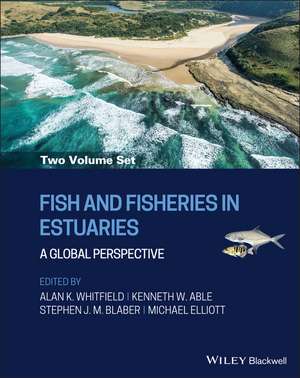Fish and Fisheries in Estuaries – A Global Perspective: A Global Perspective (V1 + V2)
Autor AK Whitfielden Limba Engleză Hardback – 2 mar 2022
Fish and Fisheries in Estuaries: A Global Perspective brings together the current state of knowledge of estuarine fish in one inclusive work. Featuring contributions by more than fifty internationally-recognized researchers and estuarine ichthyological specialists, this landmark resource covers fish assemblages and functional groups, recruitment and production in estuaries, feeding ecology and trophic dynamics, fisheries and the conservation of estuarine fish, and much more.
Thirteen in-depth chapters and two method appendices examine major aspects of fish and fisheries in estuaries throughout the world. The text describes the biology of estuarine fish and their connections with estuarine and adjacent marine and freshwater ecosystems, as well as examining the ways human industrialization and global events such as climate change are impacting both native and non-native species. Topics include habitat diversity, fish foraging behavior, ecological engineering tools and models, hazards and risks to estuarine fish and fisheries, and estuarine environmental health. Offering detailed information on the biology and ecology of estuarine fish and fisheries, this authoritative reference:
- Explores current approaches and future research directions aimed at achieving a balance between exploitation and conservation of estuarine fishes
- Discusses environmental quality objectives and sustainable management of estuary fisheries
- Addresses the impacts of increased human use of resources such as food, space, and water to estuarine fish and fisheries
- Features numerous international case studies of management of fisheries, threatened species, estuarine rehabilitation, reproduction and ontogeny, and others
- Covers study and sampling methods, field equipment, and data processing, analysis, and interpretation
Fish and Fisheries in Estuaries: A Global Perspective is an indispensable tool and reference point for fish biologists, fisheries scientists, ecologists and environmental scientists, aquatic ecologists, conservation biologists, estuarine managers and advanced students and instructors in fish biology and fisheries programs.
Preț: 2240.71 lei
Preț vechi: 3236.68 lei
-31% Nou
428.81€ • 465.63$ • 360.20£
Carte indisponibilă temporar
Specificații
ISBN-10: 1444336673
Pagini: 1120
Dimensiuni: 208 x 264 x 64 mm
Greutate: 3.33 kg
Ediția:2 Volume Set
Editura: Wiley
Locul publicării:Chichester, United Kingdom
